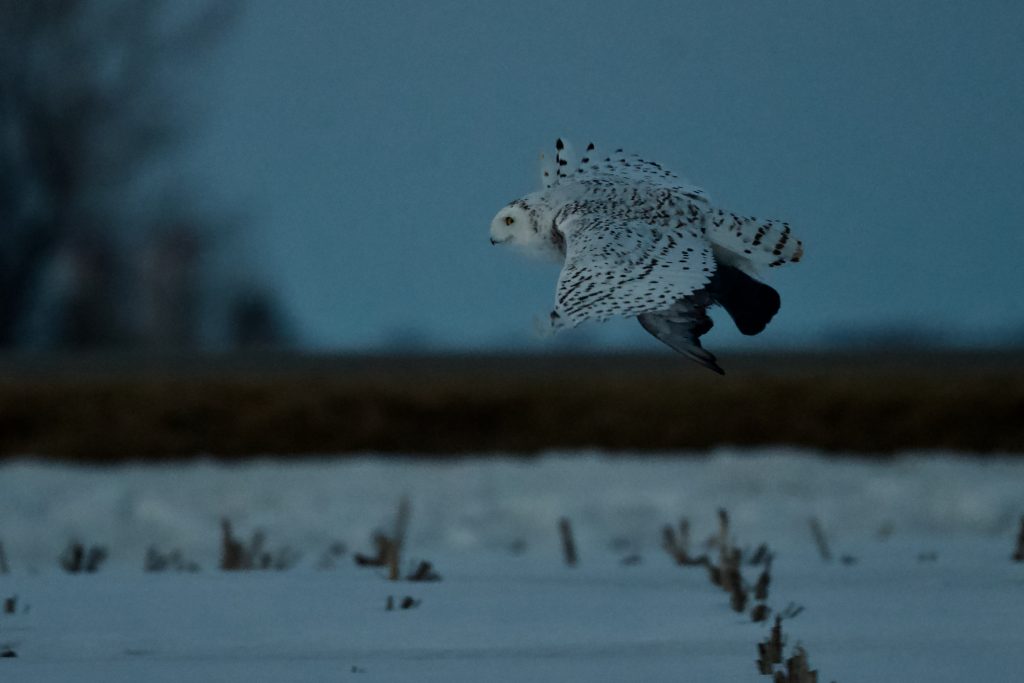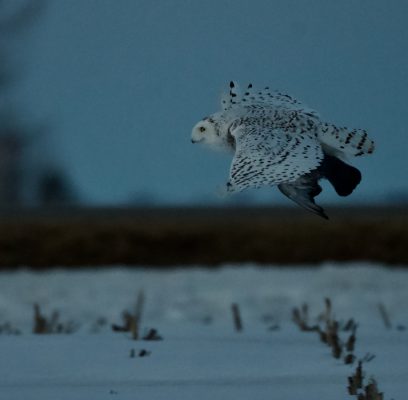This year’s visit of the snowy owls is nearing an end. Although I am still seeing many of the same owls that have been with us since December I am cognizant of the fact that a year ago the owls were all gone by mid April.
Since the owls in the area I visit are mostly of breeding age I wouldn’t doubt that a return to the Arctic breeding grounds might be even sooner.
The constant melting and freezing of snow in these fields has been a challenge sometimes. One day last week some of the fields I have permission to enter were literally flooded. That’s when I look for ‘islands of snow’ to which snowy owls often gravitate for a roosting spot. Still, I am seeing the occasional photographer and birder stopping to see these raptors.
How do I know another photographer has arrived on scene? The owls will suddenly turn their attention to the cars stopped on the road. With their sensitive hearing they can easily hear chatter, the sound of car doors slamming and footsteps. Some are still sensitive to the sound of a camera firing away. Moreover their keen eyesight will hone in on the people.
My favourite female owl watching a photographer who was walking along the nearby road.
Often I am sitting in the snow or mud for well over an hour with an individual owl and I am sure the people on the road are wondering the purpose of this.
If I wander into a field with an owl that I have spent weeks developing a comfort level with – their comfort level I might underline – it is in the hope of catching the owl hunting or taking off or exhibiting interesting behaviour.
Snowy owls will choose a roosting place and spend hours, perhaps the entire day, there. Later in the afternoon is when they prepare for the evening hunt. That’s when I see them preening (cleaning their feathers) making certain their talons are cleared of mud or ice, and, on many occasions, they will regurgitate a pellet.
A male owl near sundown stretching after roosting all afternoon. 
These large chunks of indigestible parts of the prey they swallowed in the previous 18 hours are made up of bones, teeth, and fur.
An adult male regurgitating a pellet a few days ago.

The adult male preening after regurgitating a pellet.

Last week I was joined in snowy owl country by the noted wildlife photographer Dave Sandford (www.davesandfordphotos.com).
We had met a week before when he and his friend Jade helped get my car out of a snow obstacle. By stopping to help me in my predicament they missed vital time with the owls they had come to see. So, I offered to pay him back with a ‘tour’ of snowy owls.
On this occasion, when I saw my favourite female owl roosting along a hedgerow, I drove up to the farmhouse and asked the farmer if it was ok if I brought Dave into the field with me. This fellow, it should be noted, helped dig me out of a snow filled ditch about seven years ago. He consented with a smile probably thinking ‘what are the odds’ there’d be another photographer crazy enough to trudge through the snow.
Before I went into the field I told Dave my plan: I would circle around the owl at a distance then sit down in the snow with the remaining sunlight on the owl. He politely offered to keep back a ways. If I was correct, I told him, the owl would fly past him in any case.
The owl watched me approach and once I was position she nonchalantly turned her attention to Dave who was nearer the road. We didn’t have to wait long for action. Suddenly she spotted a pigeon at her favourite grain silo three hundred metres away and shot up off the ground. We watched her rise to the height of the silo’s roof and snatch a pigeon. She returned to the same area with her catch.
I moved around a little to capture a few images of her eating her dinner. Then she got spooked. It was neither Dave nor I that caused this. Two very friendly dogs came running through the snow towards us barking. The owl suddenly took flight – right between the two of us.
The owl with her catch.

It was another great experience.
I have learned over the years to remain with a snow owl until it’s dark or the owl leaves. And there are a few times when I have taken my eye off the owl for a second and then realized I missed a shot.
Below is an image captured minutes after another photographer had left the scene – same fellow who had been watched closely by the owl in the picture at the top of this blog.
The owl flew straight across the field, gained height then swooped down on prey in the next field. She was too far away for pictures, but it was another incident that keeps me fascinated by these birds.

Wildlife photography is not an exact science. You can have favourable light but the subject doesn’t ‘cooperate’. Or, you can witness something special when the conditions are not the best. But by being out there regularly you seriously increase the chances of ‘the’ encounter of a lifetime.
-30-


Wow !!!Paul what a great story behind your photos. I am thrilled that i signed up to be on your email list to hear your stories. I belong to the Woodstock Field Naturalists Club. I can understand why the Snowy’s are one of your favorite predators.
Hi Patricia, You have a great group of people down there in Woodstock. I was very happy to present to your club twice now. Yes, the snowy owls are absolutely fantastic to watch and study and occasionally make an image of. Happy birding!!!
Thanks for another interesting story, Paul, and the lovely pics.
Hey Brad, thanks again for staying in touch. Not long to your UK trip, right? Will you be looking for birds there as well as socializing?